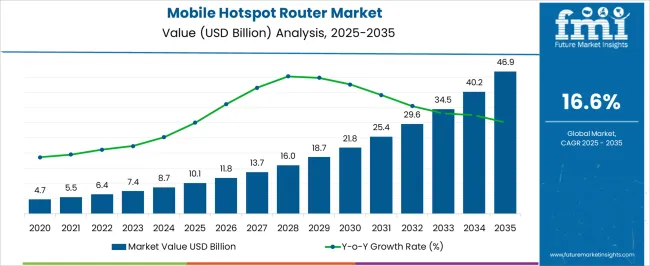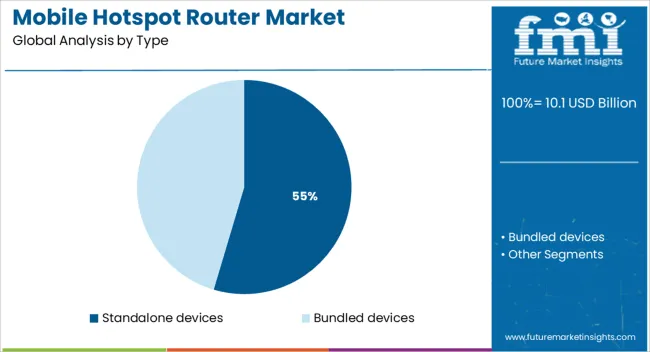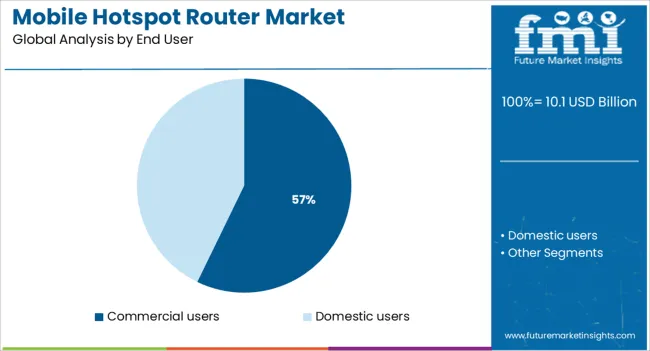The Mobile Hotspot Router Market is estimated to be valued at USD 10.1 billion in 2025 and is projected to reach USD 46.9 billion by 2035, registering a compound annual growth rate (CAGR) of 16.6% over the forecast period.

| Metric | Value |
|---|---|
| Mobile Hotspot Router Market Estimated Value in (2025 E) | USD 10.1 billion |
| Mobile Hotspot Router Market Forecast Value in (2035 F) | USD 46.9 billion |
| Forecast CAGR (2025 to 2035) | 16.6% |
The mobile hotspot router market is experiencing accelerated growth, driven by the increasing adoption of portable, wireless internet access across consumer and enterprise domains. With the proliferation of remote workforces, field operations, and travel-dependent industries, demand for secure, high-speed internet connectivity has risen substantially. The market's evolution has been supported by rapid advancements in 4G LTE and 5G network infrastructure, alongside growing affordability of data plans and IoT-compatible hardware.
Software-defined networking features and device management capabilities are enabling users to manage bandwidth and security remotely, which is proving critical in commercial and mobile enterprise scenarios. Compact design, long battery life, and multi-device connectivity have enhanced the appeal of hotspot routers across education, logistics, events, and travel segments.
Furthermore, concerns around data privacy in public Wi-Fi environments are pushing individual and institutional users to rely more heavily on private mobile hotspots Looking forward, the market is expected to gain further traction through integration with AI-driven diagnostics, advanced antenna systems, and cross-network compatibility for seamless international connectivity.
The market is segmented by Type and End User and region. By Type, the market is divided into Standalone devices and Bundled devices. In terms of End User, the market is classified into Commercial users and Domestic users. Regionally, the market is classified into North America, Latin America, Western Europe, Eastern Europe, Balkan & Baltic Countries, Russia & Belarus, Central Asia, East Asia, South Asia & Pacific, and the Middle East & Africa.

The standalone devices segment is projected to capture 54.6% of the mobile hotspot router market revenue share in 2025, reflecting its strong utility in delivering portable, high-performance wireless access. This dominance is being driven by the increasing preference for independent, SIM-based routers that do not rely on tethering from smartphones or tablets.
Standalone hotspot devices have gained popularity among frequent travelers, field service teams, and remote professionals due to their dedicated bandwidth, long battery backup, and ability to support multiple connections without performance degradation. These devices often incorporate robust signal reception capabilities and advanced heat dissipation systems, allowing for extended operation in diverse environments.
Manufacturers have focused on improving data encryption, device tracking, and over-the-air firmware updates, enhancing long-term functionality and security As reliance on real-time cloud access and video conferencing continues to grow, standalone mobile routers are being increasingly adopted across industry verticals that demand reliable, uninterrupted mobile internet without compromising device autonomy.

The commercial users segment is expected to account for 57.2% of the mobile hotspot router market revenue in 2025, emerging as the largest end-use category. This dominance is being shaped by the heightened demand for secure, scalable, and high-speed internet connectivity across various business environments. Commercial users across logistics, retail, field services, media, and construction are increasingly deploying mobile hotspot routers to enable workforce mobility, remote system monitoring, and operational continuity in areas with limited wired infrastructure.
The shift toward hybrid work models and mobile office setups has further reinforced the need for enterprise-grade portable connectivity solutions. Commercial-grade devices with enterprise-level security protocols, multi-band frequency support, and remote configuration features are being favored to ensure consistent performance across locations.
Additionally, the ability to manage large fleets of devices through centralized platforms has supported broader commercial adoption As digital transformation deepens and mobile operations become a competitive necessity, mobile hotspot routers are playing a pivotal role in bridging the connectivity gap for commercial users.
Technological Advancements in Connected Devices to Fuel Industry Expansion
Increasing demand for wireless broadband, increasing smartphone users, and growing awareness of the pay-as-you-go business model are the key factors contributing to the growth of the mobile hotspot router market globally. Increasing business travelers, expanding Wi-Fi-enabled smart devices, the growing trend of including Wi-Fi access in transportation services, and increasing adoption of long-term evolution (LTE) services are further accelerating the demand for the mobile hotspot router market globally.
Also, increasing preference for online services and continuous investment in communication infrastructure are expected to fuel the growth of the global mobile hotspot router market.
Rising disposable income increases the probability of consumer spending on media, entertainment, networking, and mobile communication - leading to higher potential sales of mobile hotspot routers. The global market is expected to witness substantial growth over the forecast period owing to advancements in the electronic, telecommunication, and e-commerce industries.
Although the mobile hotspot router market has numerous end-uses, there are numerous obstacles that likely pose a challenge to market growth. The cost and complexities related to the development of the product will hinder the growth of the market in the forecasting period.
However, limited Wi-Fi signal range, security, issues related to authentication, network performance, and increasing availability of public hotspots are identified as the restraints likely to deter the progression of the mobile hotspot router market globally.
Factors hindering the growth of the global mobile hotspot router market, are fluctuating price of raw materials being used to manufacture switches and the presence of low-quality cheap products by other manufacturers in the market key restraints of the global mobile hotspot router market.
Rapid Development in Technology to Drive the Growth of the Market in the Forecast Period
North America dominated the global mobile hotspot router market in 2025. The region is likely to account for a market share of 38.6% in global enterprise key management market. Rapid digitalization, along with the rising demand for wireless and mobile broadband services, is one of the key factors driving the growth of the market.
Region-wise, North America is anticipated to dominate the global market over the forecast period owing to the increasing number of mobile subscribers and high internet penetration mainly smartphone users. The increase in disposable incomes of middle-class households in the region is expected to augment the mobile hotspot router market.
Presence of Leading Market Providers in the Region Market Growth
According to Future Market Insights, Europe is expected to provide immense growth opportunities for the mobile hotspot router market, due to an increase in sales of hotspot routers in the European region being fueled by technological developments and a growing consumer electronics market.
The Europe mobile hotspot router market will likely account for a 23.1% share of the total global market in 2025. The growing demand for more advanced handheld devices such as smartphones and tablets is expected to create demand for technologies with high internet speed. This, in turn, is expected to drive the growth of the mobile hotspot router market.
For instance, NETGEAR®, Inc. launched the NETGEAR AirCard® 790 Mobile Hotspot (AC790) in Europe. It is the first unlockedmobile hotspot to provide ultra-fast Category 6 4G LTE speeds combined with the latest 802.11ac WiFi that also offers complete freedom of choice in wireless service providers.
Increasing Digitalization in The Region Boost the Market Growth in Coming Years
Asia Pacific is expected to show high growth rates in the next five years in the mobile hotspot router market. Some of the factors driving the growth of mobile hotspot routers in emerging markets are, rapid advancements being made in technology coupled with increasing investments in research and development is anticipated to further drive the market.
A significant change in lifestyle and increased smartphone penetration in the region are expected to drive the Asia Pacific mobile payment transaction market. Furthermore, there is an increasing involvement by the public authorities in this region to make the transaction an easy process, and they are making all efforts from their end to go cashless and promote digital transactions.
The new entrants in the mobile hotspot router market are continually indulging in several collaborations and highly investing in research and development activities to provide more convenient solutions to industry verticals. Some of the major start-ups that are leading the development of the market are- Milesight IoT, Four-Faith, Smile MBB,
Some of the key participants present in the global mobile hotspot router market include Huawei Technologies Co., Ltd., Novatel Wireless, Inc., NETGEAR, TP-Link Technologies Co., Ltd., Belkin International, Inc., Internet on the Go, Karma Mobility, Inc., D-Link Corporation and XCom Global, Inc. Alcatel, among others.
Attributed to the presence of such a high number of participants, the market is highly competitive. While global players such as Huawei Technologies Co., Ltd., Novatel Wireless, Inc., NETGEAR, TP-Link Technologies Co., Ltd., and Belkin International, Inc. account for considerable market size, several regional-level players are also operating across key growth regions, particularly in Asia Pacific.
| Report Attribute | Details |
|---|---|
| Growth Rate | CAGR of 16.6% from 2025 to 2035 |
| Expected Market Value (2025) | USD 10.1 billion |
| Anticipated Forecast Value (2035) | USD 46.9 billion |
| Base Year for Estimation | 2024 |
| Historical Data | 2020 to 2024 |
| Forecast Period | 2025 to 2035 |
| Quantitative Units | Revenue in USD Million, and CAGR from 2025 to 2035 |
| Report Coverage | Revenue Forecast, Volume Forecast, Company Ranking, Competitive Landscape, Growth Factors, Trends, and Pricing Analysis |
| Segments Covered | Type, End-user, Region |
| Regions Covered | North America; Latin America; Europe; Asia Pacific; Middle East and Africa |
| Key Countries Profiled | The USA, Canada, Mexico, Brazil, Germany, Italy, France, The United Kingdom, Spain, China, Japan, South Korea, Malaysia, Singapore, Australia, New Zealand, GCC, South Africa, Israel |
| Key Companies Profiled | Huawei Technologies Co., Ltd.; Novatel Wireless, Inc.; NETGEAR; TP-Link Technologies Co., Ltd.; Belkin International, Inc.; Internet on the Go; Karma Mobility, Inc.; D-Link Corporation; XCom Global, Inc.; Alcatel |
| Customization | Available Upon Request |
The global mobile hotspot router market is estimated to be valued at USD 10.1 billion in 2025.
The market size for the mobile hotspot router market is projected to reach USD 46.9 billion by 2035.
The mobile hotspot router market is expected to grow at a 16.6% CAGR between 2025 and 2035.
The key product types in mobile hotspot router market are standalone devices and bundled devices.
In terms of end user, commercial users segment to command 57.2% share in the mobile hotspot router market in 2025.






Our Research Products

The "Full Research Suite" delivers actionable market intel, deep dives on markets or technologies, so clients act faster, cut risk, and unlock growth.

The Leaderboard benchmarks and ranks top vendors, classifying them as Established Leaders, Leading Challengers, or Disruptors & Challengers.

Locates where complements amplify value and substitutes erode it, forecasting net impact by horizon

We deliver granular, decision-grade intel: market sizing, 5-year forecasts, pricing, adoption, usage, revenue, and operational KPIs—plus competitor tracking, regulation, and value chains—across 60 countries broadly.

Spot the shifts before they hit your P&L. We track inflection points, adoption curves, pricing moves, and ecosystem plays to show where demand is heading, why it is changing, and what to do next across high-growth markets and disruptive tech

Real-time reads of user behavior. We track shifting priorities, perceptions of today’s and next-gen services, and provider experience, then pace how fast tech moves from trial to adoption, blending buyer, consumer, and channel inputs with social signals (#WhySwitch, #UX).

Partner with our analyst team to build a custom report designed around your business priorities. From analysing market trends to assessing competitors or crafting bespoke datasets, we tailor insights to your needs.
Supplier Intelligence
Discovery & Profiling
Capacity & Footprint
Performance & Risk
Compliance & Governance
Commercial Readiness
Who Supplies Whom
Scorecards & Shortlists
Playbooks & Docs
Category Intelligence
Definition & Scope
Demand & Use Cases
Cost Drivers
Market Structure
Supply Chain Map
Trade & Policy
Operating Norms
Deliverables
Buyer Intelligence
Account Basics
Spend & Scope
Procurement Model
Vendor Requirements
Terms & Policies
Entry Strategy
Pain Points & Triggers
Outputs
Pricing Analysis
Benchmarks
Trends
Should-Cost
Indexation
Landed Cost
Commercial Terms
Deliverables
Brand Analysis
Positioning & Value Prop
Share & Presence
Customer Evidence
Go-to-Market
Digital & Reputation
Compliance & Trust
KPIs & Gaps
Outputs
Full Research Suite comprises of:
Market outlook & trends analysis
Interviews & case studies
Strategic recommendations
Vendor profiles & capabilities analysis
5-year forecasts
8 regions and 60+ country-level data splits
Market segment data splits
12 months of continuous data updates
DELIVERED AS:
PDF EXCEL ONLINE
Mobile Camping Toilet Market Size and Share Forecast Outlook 2025 to 2035
Mobile Phone Screen Underlayer Cushioning Material Market Size and Share Forecast Outlook 2025 to 2035
Mobile Application Store Market Size and Share Forecast Outlook 2025 to 2035
Mobile Money Market Forecast and Outlook 2025 to 2035
Mobile Application Testing Solution Market Size and Share Forecast Outlook 2025 to 2035
Mobile Cardiac Telemetry System Market Size and Share Forecast Outlook 2025 to 2035
Mobile Robots Market Size and Share Forecast Outlook 2025 to 2035
Mobile Crane Market Size and Share Forecast Outlook 2025 to 2035
Mobile Vascular Imaging Market Size and Share Forecast Outlook 2025 to 2035
Mobile Animal Inhalation Anesthesia Machine Market Size and Share Forecast Outlook 2025 to 2035
Mobile Unified Communications and Collaboration (UC&C) Solution Market Size and Share Forecast Outlook 2025 to 2035
Mobile Data Protection Market Size and Share Forecast Outlook 2025 to 2035
Mobile Medical Tablets Market Size and Share Forecast Outlook 2025 to 2035
Mobile WLAN Access Points Market Size and Share Forecast Outlook 2025 to 2035
Mobile Social Networks Market Size and Share Forecast Outlook 2025 to 2035
Mobile Printer Market Size and Share Forecast Outlook 2025 to 2035
Mobile Application Development Platform Market Size and Share Forecast Outlook 2025 to 2035
Mobile Threat Management Security Software Market Size and Share Forecast Outlook 2025 to 2035
Mobile Broadband Infrastructure Market Size and Share Forecast Outlook 2025 to 2035
Mobile Enterprise Application Development Platform Market Size and Share Forecast Outlook 2025 to 2035

Thank you!
You will receive an email from our Business Development Manager. Please be sure to check your SPAM/JUNK folder too.
Chat With
MaRIA